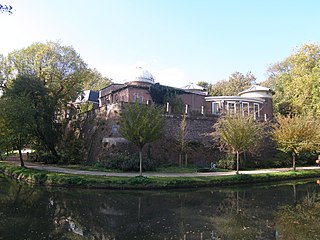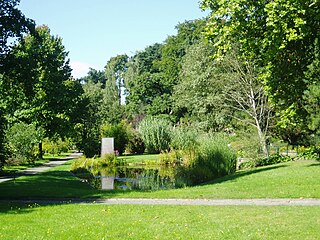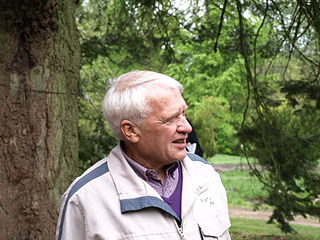
Doorn is a town in the municipality of Utrechtse Heuvelrug in the central Netherlands, in the province of Utrecht.
Utrecht Science Park is a neighbourhood in Utrecht and the largest science park in the Netherlands. It is located to the east of the city. It is the largest campus of Utrecht University. Apart from the faculties of Law, Humanities and University College Utrecht, most of the university buildings are located in Utrecht Science Park. It is also a main location of the HU University of Applied Sciences Utrecht and the University Medical Center Utrecht, and houses the main university library, student housing and botanical gardens.

An alpine garden is a domestic or botanical garden, or more often a part of a larger garden, specializing in the collection and cultivation of alpine plants growing naturally at high altitudes around the world, such as in the Caucasus, Pyrenees, Rocky Mountains, Alps, Himalayas and Andes. It is one of the most common types of rock garden.

The Hortus botanicus of Leiden is the oldest botanical garden of the Netherlands, and one of the oldest in the world. It is located in the southwestern part of the historical centre of the city, between the Academy building and the old Leiden Observatory building.

Sonnenborgh Observatory is an astronomical observatory and museum open to the public, located in Utrecht, Netherlands. It is located in one of the four stone forts built by Charles V as defense buildings for Utrecht. In 1639 the fort was expanded with an academic herbal garden by members of Utrecht University, three years after its founding. The garden was moved in 1724 to the current location of the Oude Hortus. During reconstruction works in 2001 remains were found of the first chemical laboratory in Utrecht, third in the world. The lab was led by the first chemistry-only professor in Utrecht Johann Conrad Barchusen.

The Wych Elm cultivar Ulmus glabra 'Cornuta', in cultivation before 1845 – Fontaine (1968) gives its provenance as France, 1835 – is a little-known tree, finally identified as a cultivar of U. glabra by Boom in Nederlandse Dendrologie 1: 157, 1959.

The 'dwarf' elm cultivar Ulmus 'Jacqueline Hillier' ('JH') is an elm of uncertain origin. It was cloned from a specimen found in a private garden in Selly Park, Birmingham, England, in 1966. The garden's owner told Hillier that it might have been introduced from outside the country by a relative. Hillier at first conjectured U. minor, as did Heybroek (2009). Identical-looking elm cultivars in Russia are labelled forms of Siberian Elm, Ulmus pumila, which is known to produce 'JH'-type long shoots. Melville considered 'JH' a hybrid cultivar from the 'Elegantissima' group of Ulmus × hollandica. Uncertainty about its parentage has led most nurserymen to list the tree simply as Ulmus 'Jacqueline Hillier'. 'JH' is not known to produce flowers and samarae, or root suckers.

The Orto Botanico dell'Università di Modena e Reggio Emilia, also known as the Orto Botanico di Modena or formerly Hortus Botanicus Mutinensis, is a botanical garden operated by the University of Modena and Reggio Emilia. It is located next to the Garden Ducale, at viale Caduti in Guerra 127, Modena, Italy, and open weekdays during the warmer months except August. Admission is free.

Von Gimborn Arboretum is a large living collection of woody plants in the Netherlands.The arboretum is situated in Doorn, province of Utrecht, about 25 km to the east from the city of Utrecht, and together with its nursery currently occupies an area of 27 ha. It is named after its founder, German ink manufacturer Max Th. Von Gimborn (1872–1964), which started it in 1924 as a private collection of conifers and ericaceous plants. The collection was laid down as a 23 ha landscape garden designed by Gerard Bleeker. It is still one of the largest conifer collections in Western Europe, though now it contains many other trees and shrubs as well. It holds national plant collections of conifers, Ericaceae, Aceraceae, Betulaceae, Euonymus, Fraxinus, Laburnum, Magnolia and Syringa. A number of cultivars of woody plants originate there. The arboretum is open to the public daily for a small fee.

The Leipzig Botanical Garden is a 3.5-hectare botanical garden maintained by the University of Leipzig and is located at Linnéstraße 1, Leipzig, Saxony, Germany. It is the oldest botanical garden in Germany and among the oldest in the world, and open daily without charge.

The Old Botanical Garden of Göttingen University, with an area of 4.5 hectares, is an historic botanical garden maintained by the University of Göttingen. It is located in the Altstadt at Untere Karspüle 1, adjacent to the city wall, Göttingen, Lower Saxony, Germany, and open daily.

The Botanische Garten der Martin-Luther-Universität Halle-Wittenberg is an arboretum and botanical garden maintained by the University of Halle-Wittenberg. It is located at Am Kirchtor 3 in the city of Halle, Saxony-Anhalt, Germany, and open daily in the warmer months. An admission fee is charged.

The Botanical Garden in Potsdam, is a botanical garden and arboretum maintained by the University of Potsdam. It has a total area of 8.5 hectares, of which 5 hectares are open to the public, and is located immediately southwest of the Orangery Palace at Maulbeerallee 2, Potsdam, in the German state of Brandenburg. It is open daily; an admission fee is charged for the glasshouses only (2017).

The Botanischer Garten Frankfurt am Main is a botanical garden and arboretum formerly maintained by the Goethe University and since 2012 administered by the City of Frankfurt. It is located at Siesmayerstraße 72, Frankfurt am Main, Germany, and opens daily in the warmer months.

The Späth-Arboretum is an arboretum now maintained by the Humboldt University of Berlin. It is located at Späthstraße 80/81, Berlin, Germany, and open several days per week in the warmer months.

The Botanischer Garten der Universität Tübingen, also known as the Botanischer Garten Tübingen or the Neuer Botanischer Garten Tübingen, is a botanical garden and arboretum maintained by the University of Tübingen. It is located at Hartmeyerstrasse 123, Tübingen, Baden-Württemberg, Germany, and open daily.
Science Museums, Aarhus, founded 1 January 2008, is an umbrella organization comprising the Steno Museum, the greenhouses at Aarhus Botanical Gardens, the Ole Rømer Observatory and a herbarium in Aarhus, Denmark. The Science Museums works as an independent institution under the Science and Technology department of Aarhus University.

Petrus Cornelis (Piet) de Jong is a Dutch dendrologist.
Erik Albert Mennega was a Dutch botanist, plant taxonomist, and author.

















